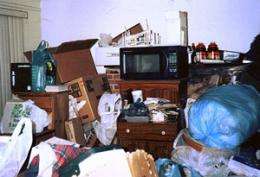Just messy or is it hoarding? Sorting out darker reality hidden inside clutter

It was a living room, but barely looked like one. The lecture-hall audience grew quiet seeing a photo of a room cluttered with mail, bills, and boxes projected onto the screen. The couch had only one empty spot – a butt-size space that faced the TV.
The scene changed to the “after” photo, and a collective “Whoa!” reverberated throughout Kane 120 as 400 Psychology 101 students took in the de-cluttered room: beige carpeting with a beige couch and chairs, a coffee table, some lamps and the TV.
We joke about being pack rats or collectors. But an overflowing garage or extensive collection of whosiewhatsits does not signal hoarding. What separates hoarders is that their extreme clutter causes shame, takes over their lives and prevents use of the home. It’s a prevalent mental health problem that currently has no formal diagnostic criteria and is extremely hard to treat.
“If you watch hoarding reality shows, the producers often bring in a professional organizer, rather than a psychotherapist, under the assumption that these folks are just disorganized,” said Kevin King, UW assistant psychology professor. “The research on hoarding is behind that on obsessive-compulsive disorder, and the popular culture reflects this.”
Hoarding is classified as a type of obsessive-compulsive disorder, but emerging evidence suggests that it’s a much different condition. King chose hoarding for his class to highlight a real-world psychological problem and discuss a scientifically-sound treatment. He invited Travis Osborne, a Seattle psychologist who treats hoarding and has made appearances on The Learning Channel’s “Hoarding: Buried Alive,” to give a guest lecture.
Osborne believes there is a spectrum of how people deal with stuff. There are the minimalists – “think IKEA catalog,” he said – and then in ascending levels of disarray, there are normal consumers, collectors, disorganized types and then finally hoarders.
“Many hoarders like to think of themselves as collectors,” said Osborne, who is also a clinical instructor in the UW department of psychology and has worked with hoarders for about five years. “But collectors take pride in their possessions, whereas hoarders feel shame when other people see all of the stuff that they have in their homes.”
Hoarding is a common psychiatric issue, with between 2.5 - 5 percent of the population afflicted. According to the 5 percent estimate, as many as 96,000 King County residents could have trouble with hoarding. But few hoarders come in for treatment, Osborne said. He also said that studies suggest that more men than women hoard, and hoarding may be more prevalent in older adults, though that’s probably just due to years of not throwing stuff away.
“Hoarding almost always starts in childhood, where they have a really hard time getting rid of things,” he said. But youngsters’ hoarding tendencies can take a while to become apparent. “If there are parents or other people in the house getting rid of things, stuff doesn’t build up as much until they live on their own.”
Some hoarders are so embarrassed by their mess that they will live without heat or water rather than have a handyman come in. In one hoarding case that Osborne treated, a kitchen was rendered unusable for 10 years, and the occupants prepared their food with a microwave and mini-fridge.
Medications don’t really put a dent in hoarding, and Osborne said that there are tremendous obstacles to treating it through behavioral interventions.
Few studies have examined treatments for hoarding, but cognitive-behavioral therapy shows promise. It involves a mix of 26 home and office visits and takes many patients about a year to complete. Once completed, studies have shown that about 70 percent of patients are rated as improved by their therapists.
Osborne uses this therapy with his hoarding patients. He coaches them through their problems and accompanies them on shopping excursions or where they get free stuff to help them practice walking away from items. If they protest, he tells them to think about the item for 24 hours and then see how strongly they feel about it.
“What people usually find is that the feeling to acquire something is usually gone within minutes or hours,” Osborne said. This is usually surprising to patients, because they think that the urge to get an item will “torture them forever.”
He also helps hoarders practice getting rid of things, by having them prioritize what they can throw out first. “The more that they practice this, the easier it gets,” Osborne said.
But even when the house is clear, many people who hoard have deficits in various information processing skills that make maintaining tidiness a struggle. “We teach them problem solving and organizational skills to hopefully help them keep up the progress they’ve made,” Osborne said.
Patients need to continue to practice the skills they learned in treatment and catch their lapses as they happen. And those folks, "really can make significant improvements in their quality of life,” he said.















